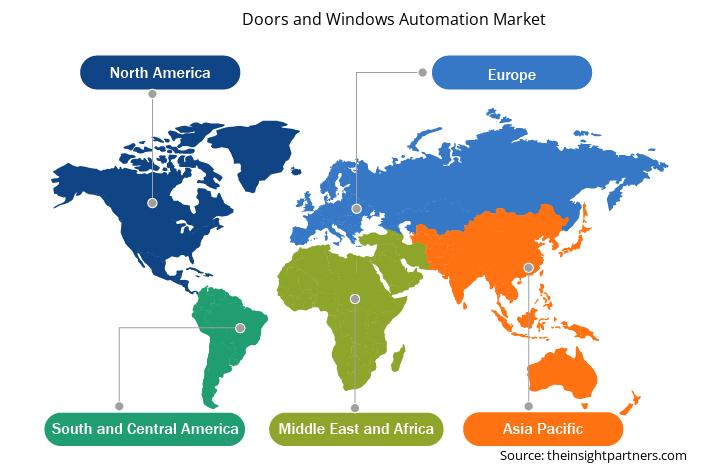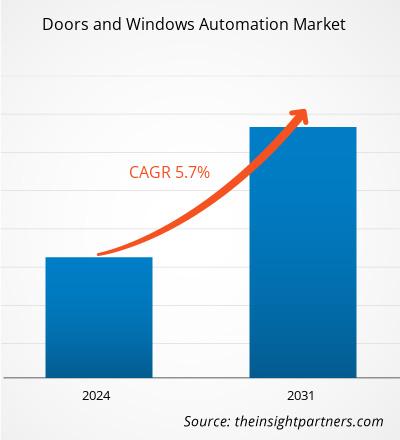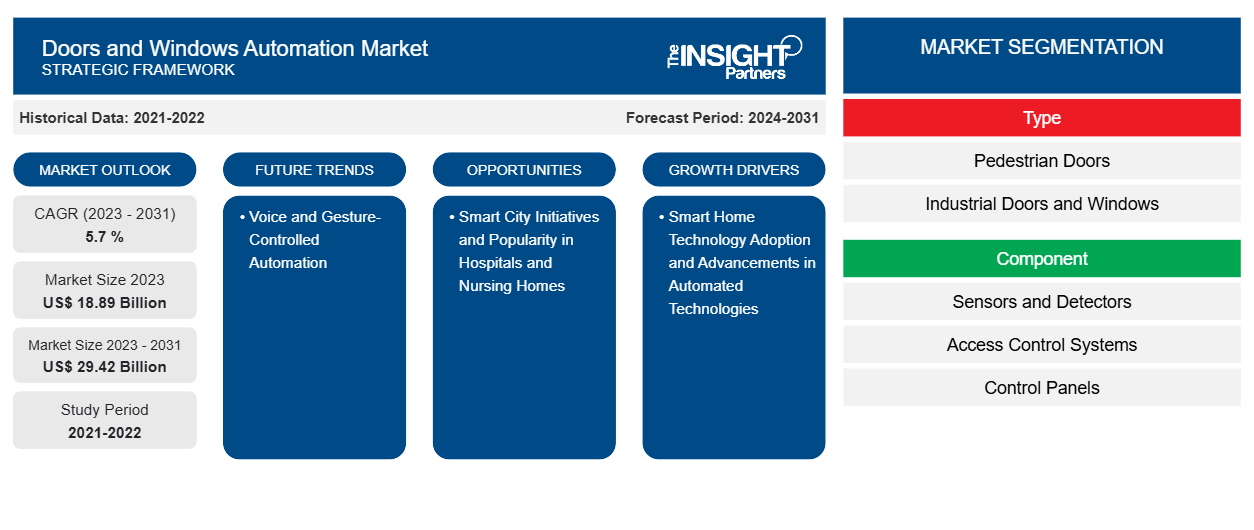Der Markt für Tür- und Fensterautomatisierung wird voraussichtlich von 18,89 Milliarden US-Dollar im Jahr 2023 auf 29,42 Milliarden US-Dollar im Jahr 2031 anwachsen. Der Markt wird zwischen 2023 und 2031 voraussichtlich eine durchschnittliche jährliche Wachstumsrate von 5,7 % verzeichnen. Sprach- und gestengesteuerte Automatisierung wird in den kommenden Jahren wahrscheinlich neue Trends auf den Markt für Tür- und Fensterautomatisierung bringen.
Marktanalyse für die Automatisierung von Türen und Fenstern
Faktoren wie die Einführung von Smart-Home-Technologien und Fortschritte bei Automatisierungstechnologien treiben den Markt für Tür- und Fensterautomatisierung an . Aufgrund zunehmender Smart-City-Initiativen und der steigenden Beliebtheit automatisierter Systeme in Krankenhäusern und Pflegeheimen wird erwartet, dass der Markt im Prognosezeitraum wächst. Die Nachfrage nach Tür- und Fensterautomatisierungslösungen wird von mehreren Schlüsselfaktoren getrieben, darunter der steigenden Nachfrage nach Komfort, Sicherheit und Energieeffizienz in Wohn- und Geschäftsgebäuden. Technologische Fortschritte wie die Integration von Smart-Home-Systemen, Sprach- und Gestensteuerung und Bewegungssensoren verbessern das Benutzererlebnis und ermöglichen eine nahtlose Automatisierung. Der zunehmende Fokus auf Nachhaltigkeit trägt ebenfalls zum Marktwachstum bei, da automatisierte Türen und Fenster die Belüftung optimieren und den Energieverbrauch senken, was zu Kosteneinsparungen führt. Darüber hinaus hat das wachsende Bewusstsein für Hygiene, insbesondere im Gesundheitswesen und in gewerblichen Einrichtungen, die Einführung berührungsloser Automatisierungssysteme beschleunigt. Diese Faktoren sowie die Urbanisierung und eine wachsende Präferenz für intelligente, vernetzte Häuser treiben die Expansion des Marktes voran.
Marktübersicht zur Tür- und Fensterautomatisierung
Unter Tür- und Fensterautomatisierung versteht man die Integration fortschrittlicher Technologien, die den automatischen Betrieb von Türen und Fenstern ermöglichen und so Komfort, Sicherheit, Energieeffizienz und Zugänglichkeit verbessern. Diese Automatisierung kann durch Sensoren, Motoren und Steuerungssysteme erreicht werden, die das Öffnen oder Schließen von Türen und Fenstern je nach bestimmten Bedingungen oder Benutzerbefehlen ermöglichen. Zu den gängigen Funktionen gehören berührungslose, sprachaktivierte oder gestengesteuerte Bedienung sowie die intelligente Integration mit Hausautomationssystemen für eine nahtlose Steuerung über Plattformen wie Amazon Alexa oder Google Assistant. Diese automatisierten Systeme werden zunehmend sowohl in Wohn- als auch in Geschäftsgebäuden eingesetzt und bieten Vorteile wie erhöhte Sicherheit, Energieeinsparungen durch optimierte Belüftung und verbesserte Hygiene durch Reduzierung des physischen Kontakts mit Oberflächen.
Passen Sie diesen Bericht Ihren Anforderungen an
Sie erhalten kostenlos individuelle Anpassungen an jedem Bericht, einschließlich Teilen dieses Berichts oder einer Analyse auf Länderebene, eines Excel-Datenpakets sowie tolle Angebote und Rabatte für Start-ups und Universitäten.
-
Holen Sie sich die wichtigsten Markttrends aus diesem Bericht.Dieses KOSTENLOSE Beispiel umfasst eine Datenanalyse von Markttrends bis hin zu Schätzungen und Prognosen.
Markttreiber und Chancen für die Tür- und Fensterautomatisierung
Einführung von Smart-Home-Technologie
Smart Homes integrieren Tür- und Fensterautomatisierungssysteme, da Hausbesitzer mehr Komfort, Energieeffizienz und Sicherheit wünschen. Als Teil des breiteren Trends der Smart-Home-Technologien und der zunehmenden Verfügbarkeit vernetzter Geräte integrieren Verbraucher zunehmend automatisierte Systeme in ihre Häuser, um das tägliche Wohnerlebnis zu verbessern und den Energieverbrauch zu senken. Unternehmen wie Marvin, Somfy, WindowMaster und View Glass bieten fortschrittliche Lösungen, die automatisierte Türen und Fenster mit Smart Homes verbinden. So kündigte Somfy, der weltweit führende Hersteller von Motoren für Innenfensterabdeckungen und Außensonnenschutz, im September 2023 seine Integration und Zertifizierung mit Apple Home an. Diese Zertifizierung ermöglicht eine nahtlose Kompatibilität zwischen den von Somfy unterstützten Zigbee-Motoren, die in Innenfensteranwendungen verwendet werden, und dem TaHoma-Schalter mit Apple Home. Die Zigbee 3.0-Technologie, eine weltweit eingesetzte und sichere IoT-Lösung, erleichtert die Interoperabilität, indem sie Smart-Home-Geräte mit einem einheitlichen Netzwerk verbindet, sodass die Produkte reibungslos funktionieren. Die neue Integration bietet eine einfache und sichere Möglichkeit, motorisierte Fensterabdeckungen mit Zigbee-Motoren von Somfy über die Apple Home-App und Siri auf Geräten wie iPhone, iPad, Apple Watch, HomePod und Mac zu steuern. Die Einführung von Smart-Home-Technologie treibt somit den Markt für Tür- und Fensterautomatisierung voran.
Smart City-Initiativen
Städte werden technologisch immer fortschrittlicher und vernetzter, was zu einer wachsenden Nachfrage nach automatisierter Infrastruktur führt, die den Gebäudebetrieb optimieren, die Sicherheit erhöhen und die Energieeffizienz verbessern kann. Laut dem Entwicklungsprogramm der Vereinten Nationen leben mehr als 60 % der Weltbevölkerung in Städten, davon mehr als 70 % der Erwerbstätigen; außerdem werden 80 % des weltweiten wirtschaftlichen Werts in Städten erwirtschaftet. Regierungen verschiedener Länder ergreifen Initiativen für Smart Cities, die sich darauf konzentrieren, das Internet zu nutzen, um Informationen auszutauschen, die Betriebseffizienz zu verbessern und den in Smart Cities lebenden Bürgern eine bessere Servicequalität zu bieten. So gibt es beispielsweise laut dem Ministerium für Stadtentwicklung insgesamt 8.033 (Smart Cities Mission)-Projekte in 100 Städten Indiens, von denen 7.038 (88 %) bereits abgeschlossen und 995 (12 %) laufende Projekte sind. Ebenso kündigte die chinesische Regierung im Jahr 2023 ihren Plan an, mehr als 500 Smart Cities zu bauen. Im Juli 2023 finanzierte die Regierung ein Projekt im Wert von 200 Millionen US-Dollar zur Entwicklung der Phase 1 des Guangzhou Smart City-Projekts. Smart City-Initiativen beinhalten die Einführung verschiedener intelligenter Technologien, darunter Tür- und Fensterautomatisierungssysteme, die den Betrieb energieeffizienter und nachhaltiger machen und den Kohlenstoffausstoß minimieren. Auch in Dubai werden mehrere Geschäftsgebäude mit automatisierten Türen und Fenstern ausgestattet, als Teil der Vision der Stadt, eine der weltweit führenden Smart Cities zu werden, und unterstützen die Integration intelligenter Technologien für Nachhaltigkeit und Komfort. Darüber hinaus ist Dubai weiterhin führend in der Entwicklung von Smart Cities, mit Projekten wie der Dubai Silicon Oasis, die automatisierte Türen und Fenster integrieren, um die Energieeffizienz in Geschäfts- und Wohngebäuden zu optimieren. Diese Systeme sind so konzipiert, dass sie sich automatisch an die Wetterbedingungen anpassen und so zur Energieeinsparung und zum Ziel der Stadt beitragen, den Kohlenstoffausstoß zu reduzieren. Daher wird erwartet, dass die steigende Zahl von Initiativen in Smart City -Projekten im Prognosezeitraum verschiedene Möglichkeiten für das Marktwachstum schaffen wird.
Segmentierungsanalyse des Marktberichts zur Automatisierung von Türen und Fenstern
Wichtige Segmente, die zur Ableitung der Marktanalyse für die Tür- und Fensterautomatisierung beigetragen haben, sind Typ, Komponente, Steuerungssystem und Branche.
- Basierend auf dem Typ wird der Markt für Tür- und Fensterautomatisierung in Fenster, Industrietüren und Fußgängertüren unterteilt. Das Segment Fußgängertüren dominierte den Markt im Jahr 2023.
- In Bezug auf die Komponenten ist der Markt für Tür- und Fensterautomatisierung in Zugangskontrollsysteme, Bedienfelder, Sensoren und Detektoren, Motoren und Aktuatoren und andere unterteilt. Das Segment Sensoren und Detektoren hatte im Jahr 2023 den größten Marktanteil.
- Nach Steuerungssystem ist der Markt für Tür- und Fensterautomatisierung in vollautomatische, halbautomatische und Servosysteme unterteilt. Das vollautomatische Segment dominierte den Markt im Jahr 2023.
- Basierend auf der Branchenvertikale wird der Markt für Tür- und Fensterautomatisierung in Wohn-, Gewerbe- und Industriebereiche unterteilt. Das gewerbliche Segment hatte im Jahr 2023 den größten Anteil am Markt für Tür- und Fensterautomatisierung.
Marktanteilsanalyse für die Tür- und Fensterautomatisierung nach geografischen Gesichtspunkten
Der Markt für Tür- und Fensterautomatisierung ist in fünf große Regionen unterteilt: Nordamerika, Europa, Asien-Pazifik (APAC), Naher Osten und Afrika (MEA) sowie Süd- und Mittelamerika. Nordamerika dominierte den Markt im Jahr 2023, gefolgt von Europa und APAC.
Der Markt für Tür- und Fensterautomatisierung in Nordamerika ist in die USA, Kanada und Mexiko unterteilt. In bedeutenden Ländern Nordamerikas ist ein deutlicher Anstieg von Smart Homes und Smart City-Programmen zu verzeichnen. Die Regierungen verschiedener Länder in der Region fördern die Einführung von Smart Cities, was voraussichtlich die Wohn- und Gewerbebautätigkeit ankurbeln und die Nachfrage nach automatisierten Türen und Fenstern steigern wird. Die Integration von Automatisierungstechnologie in Tür- und Fenstersysteme hilft beim Energiesparen, da sie dazu beiträgt, Türen und Fenster für einen optimalen Zeitraum ver- oder entriegelt zu halten.
Regionale Einblicke in den Markt für Tür- und Fensterautomatisierung
Die regionalen Trends und Faktoren, die den Markt für Tür- und Fensterautomatisierung während des gesamten Prognosezeitraums beeinflussen, wurden von den Analysten von Insight Partners ausführlich erläutert. In diesem Abschnitt werden auch die Marktsegmente und die Geografie der Tür- und Fensterautomatisierung in Nordamerika, Europa, im asiatisch-pazifischen Raum, im Nahen Osten und Afrika sowie in Süd- und Mittelamerika erörtert.

- Erhalten Sie regionale Daten zum Markt für Tür- und Fensterautomatisierung
Umfang des Marktberichts zur Automatisierung von Türen und Fenstern
| Berichtsattribut | Details |
|---|---|
| Marktgröße im Jahr 2023 | 18,89 Milliarden US-Dollar |
| Marktgröße bis 2031 | 29,42 Milliarden US-Dollar |
| Globale CAGR (2023 - 2031) | 5,7 % |
| Historische Daten | 2021-2022 |
| Prognosezeitraum | 2024–2031 |
| Abgedeckte Segmente |
Nach Typ
|
| Abgedeckte Regionen und Länder |
Nordamerika
|
| Marktführer und wichtige Unternehmensprofile |
|
Dichte der Marktteilnehmer für die Automatisierung von Türen und Fenstern: Verständnis ihrer Auswirkungen auf die Geschäftsdynamik
Der Markt für Tür- und Fensterautomatisierung wächst rasant. Dies wird durch die steigende Nachfrage der Endnutzer aufgrund von Faktoren wie sich entwickelnden Verbraucherpräferenzen, technologischen Fortschritten und einem größeren Bewusstsein für die Vorteile des Produkts vorangetrieben. Mit der steigenden Nachfrage erweitern Unternehmen ihr Angebot, entwickeln Innovationen, um die Bedürfnisse der Verbraucher zu erfüllen, und nutzen neue Trends, was das Marktwachstum weiter ankurbelt.
Die Marktteilnehmerdichte bezieht sich auf die Verteilung der Firmen oder Unternehmen, die in einem bestimmten Markt oder einer bestimmten Branche tätig sind. Sie gibt an, wie viele Wettbewerber (Marktteilnehmer) in einem bestimmten Marktraum im Verhältnis zu seiner Größe oder seinem gesamten Marktwert präsent sind.
Die wichtigsten Unternehmen auf dem Markt für Tür- und Fensterautomatisierung sind:
- ABB Ltd
- Allegion Plc
- Assa Abloy AB
- Came SpA
- Honeywell International Inc
- Insteon
Haftungsausschluss : Die oben aufgeführten Unternehmen sind nicht in einer bestimmten Reihenfolge aufgeführt.

- Überblick über die wichtigsten Akteure auf dem Markt für Tür- und Fensterautomatisierung
Marktnachrichten und aktuelle Entwicklungen zur Automatisierung von Türen und Fenstern
Der Markt für Tür- und Fensterautomatisierung wird durch die Erhebung qualitativer und quantitativer Daten nach Primär- und Sekundärforschung bewertet, die wichtige Unternehmensveröffentlichungen, Verbandsdaten und Datenbanken umfasst. Nachfolgend sind einige der wichtigsten Entwicklungen auf dem Markt für Tür- und Fensterautomatisierung aufgeführt:
- Allegion plc hat über eine seiner Tochtergesellschaften SOSS Door Hardware (SOSS) übernommen. Als führender Hersteller hochwertiger Scharniere und Türbeschläge verkauft SOSS seine Lösungen hauptsächlich auf nordamerikanischen Nichtwohnmärkten. Die Lösungen von SOSS ergänzen die Türbeschläge der Marken Ives, Glynn-Johnson und Zero International des Unternehmens und ermöglichen es dem Unternehmen, seinen Kunden ein breiteres Portfolio anzubieten und diesen Kernbereich des Geschäfts letztlich auszubauen.
(Quelle: Allegion plc, Pressemitteilung, Oktober 2024)
- ABB hat auf der diesjährigen Messe Light + Building in Frankfurt Upgrades für sein Portfolio an ABB-Welcome-Türsprechanlagen vorgestellt. Die Versionen der nächsten Generation von ABB-Welcome und ABB-Welcome IP wurden mit weiterentwickeltem Design, vereinfachter Systemarchitektur und verbesserter Konnektivität eingeführt. ABB-Welcome bietet eine vielseitige 2-Draht-Lösung für die Türkommunikation mit einer breiten Palette modularer Designs. Es umfasst eine vollständige Palette von Außen- und Innenstationen. Hauseingangsbereiche, einschließlich Tore und Haus- oder Eingangstüren, können bequem mit Mobiltelefonen verbunden werden, um schneller auf Anrufe an der Tür reagieren zu können; außerdem kann der Zugang per Fernzugriff über eine App gewährt werden.
(Quelle: ABB, Pressemitteilung, März 2024)
Marktbericht zur Automatisierung von Türen und Fenstern – Umfang und Ergebnisse
Die „Marktgröße und Prognose für die Automatisierung von Türen und Fenstern (2021–2031)“ bietet eine detaillierte Analyse des Marktes, die die unten genannten Bereiche abdeckt:
- Marktgröße und Prognose für die Automatisierung von Türen und Fenstern auf globaler, regionaler und Länderebene für alle wichtigen Marktsegmente, die im Rahmen des Berichts abgedeckt sind
- Markttrends und Marktdynamiken für die Automatisierung von Türen und Fenstern wie Treiber, Einschränkungen und wichtige Chancen
- Detaillierte PEST- und SWOT-Analyse
- Marktanalyse für die Automatisierung von Türen und Fenstern, die wichtige Markttrends, globale und regionale Rahmenbedingungen, wichtige Akteure, Vorschriften und aktuelle Marktentwicklungen umfasst
- Branchenlandschaft und Wettbewerbsanalyse, einschließlich Marktkonzentration, Heatmap-Analyse, prominenten Akteuren und aktuellen Entwicklungen auf dem Markt für Tür- und Fensterautomatisierung
- Detaillierte Firmenprofile
- Historische Analyse (2 Jahre), Basisjahr, Prognose (7 Jahre) mit CAGR
- PEST- und SWOT-Analyse
- Marktgröße Wert/Volumen – Global, Regional, Land
- Branchen- und Wettbewerbslandschaft
- Excel-Datensatz
Aktuelle Berichte
Verwandte Berichte
Erfahrungsberichte
Grund zum Kauf
- Fundierte Entscheidungsfindung
- Marktdynamik verstehen
- Wettbewerbsanalyse
- Kundeneinblicke
- Marktprognosen
- Risikominimierung
- Strategische Planung
- Investitionsbegründung
- Identifizierung neuer Märkte
- Verbesserung von Marketingstrategien
- Steigerung der Betriebseffizienz
- Anpassung an regulatorische Trends























 Kostenlose Probe anfordern für - Markt für Türen- und Fensterautomatisierung
Kostenlose Probe anfordern für - Markt für Türen- und Fensterautomatisierung